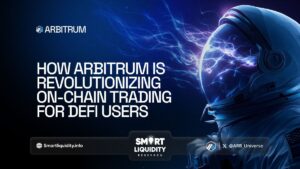Scaling Ethereum with Arbitrum’s Optimistic Rollups


Scaling Ethereum with Arbitrum’s Optimistic Rollups! The scalability trilemma has long been a central challenge in the blockchain space, particularly evident in Ethereum’s journey.
As the demand for decentralized applications (dApps) and smart contracts surged, Ethereum faced congestion issues and soaring gas fees, hindering its scalability and usability. Amidst this challenge, layer 2 scaling solutions emerged as a beacon of hope, promising to address Ethereum’s scalability constraints without compromising on decentralization and security.
One such solution that has gained considerable attention is Arbitrum, leveraging the power of Optimistic Rollups to significantly enhance Ethereum’s throughput and reduce transaction costs. In this technical deep dive, we’ll embark on a journey to unravel the intricate workings of Arbitrum’s Optimistic Rollups and understand how they hold the potential to revolutionize Ethereum’s scalability landscape.
Understanding the Scalability Challenge
Before delving into Arbitrum’s solution, it’s imperative to grasp the scalability challenge plaguing Ethereum. As one of the pioneering blockchain platforms, Ethereum garnered immense popularity, serving as the foundation for a myriad of decentralized applications, decentralized finance (DeFi) protocols, and non-fungible tokens (NFTs). However, Ethereum’s scalability limitations became glaringly apparent as network congestion escalated, leading to exorbitant gas fees and sluggish transaction processing times.
The scalability trilemma posits that blockchain systems can only optimize two out of three essential attributes: scalability, decentralization, and security. Ethereum prioritized decentralization and security, fostering a robust and censorship-resistant network but at the expense of scalability. Consequently, the need for scalable solutions that could alleviate Ethereum’s congestion woes became increasingly pressing.
Enter Arbitrum: A Beacon of Scalability
Arbitrum emerges as a promising solution to Ethereum’s scalability predicament, introducing the concept of Optimistic Rollups to enhance throughput and scalability while preserving Ethereum’s security guarantees and decentralized ethos. At its core, Arbitrum operates as a layer 2 scaling solution, offering a framework for executing smart contracts and processing transactions off-chain while periodically anchoring them to Ethereum’s mainnet for security validation.
Optimistic Rollups, the cornerstone of Arbitrum’s architecture, revolutionize transaction processing by aggregating multiple off-chain transactions into a single compact proof, subsequently committing them to Ethereum’s mainnet. This approach drastically reduces the computational overhead and transaction costs associated with on-chain execution, enabling Arbitrum to achieve unparalleled scalability without compromising on security or decentralization.
Technical Deep Dive into Arbitrum’s Optimistic Rollups
To comprehend the inner workings of Arbitrum’s Optimistic Rollups, let’s dissect its technical components:
- Off-chain Execution
Arbitrum conducts smart contract execution and transaction processing off-chain, leveraging its optimistic execution environment to validate transactions without immediate on-chain confirmation. This off-chain execution significantly boosts throughput and reduces latency, laying the foundation for enhanced scalability. - Fraud Proofs
In the optimistic rollup paradigm, validators assume transactions to be valid by default, allowing for rapid off-chain execution. However, in case of fraudulent activities, anyone can submit fraud proofs to Ethereum’s mainnet, triggering contract state reversion and penalizing malicious actors. This fraud-proof mechanism ensures that security remains paramount, safeguarding Ethereum’s integrity while enabling off-chain scalability. - Periodic Commitments
Arbitrum periodically anchors aggregated transaction batches, along with associated Merkle proofs, to Ethereum’s mainnet, providing a succinct summary of off-chain activities for security validation. These commitments serve as checkpoints, enabling Ethereum validators to verify the integrity of off-chain transactions and enforce consensus without scrutinizing individual transactions, thereby minimizing on-chain overhead. - Rollup Validators
Validators play a pivotal role in Arbitrum’s consensus mechanism, overseeing off-chain transaction execution and generating fraud proofs when necessary. These validators ensure the integrity of off-chain state transitions and validate transactions before anchoring them to Ethereum’s mainnet, preserving the network’s security guarantees while enabling scalable transaction processing.
In Summary
Arbitrum’s Optimistic Rollups herald a new era of scalability for Ethereum, offering a compelling solution to its longstanding congestion woes. By combining off-chain execution with periodic on-chain anchoring and fraud-proof mechanisms, Arbitrum achieves unprecedented scalability without compromising on decentralization or security.
As Ethereum continues its journey towards Ethereum 2.0 and sharding, layer 2 scaling solutions like Arbitrum serve as invaluable stopgap measures, alleviating immediate scalability constraints while paving the way for a seamless transition to a fully scalable and decentralized Ethereum ecosystem.
In the ever-evolving landscape of blockchain technology, Arbitrum stands as a testament to innovation, embodying the ethos of scalability, security, and decentralization that underpin Ethereum’s transformative potential. As we embrace the dawn of a more scalable Ethereum, fueled by the power of Optimistic Rollups, the future of decentralized finance, digital assets, and decentralized applications appears brighter than ever before.




